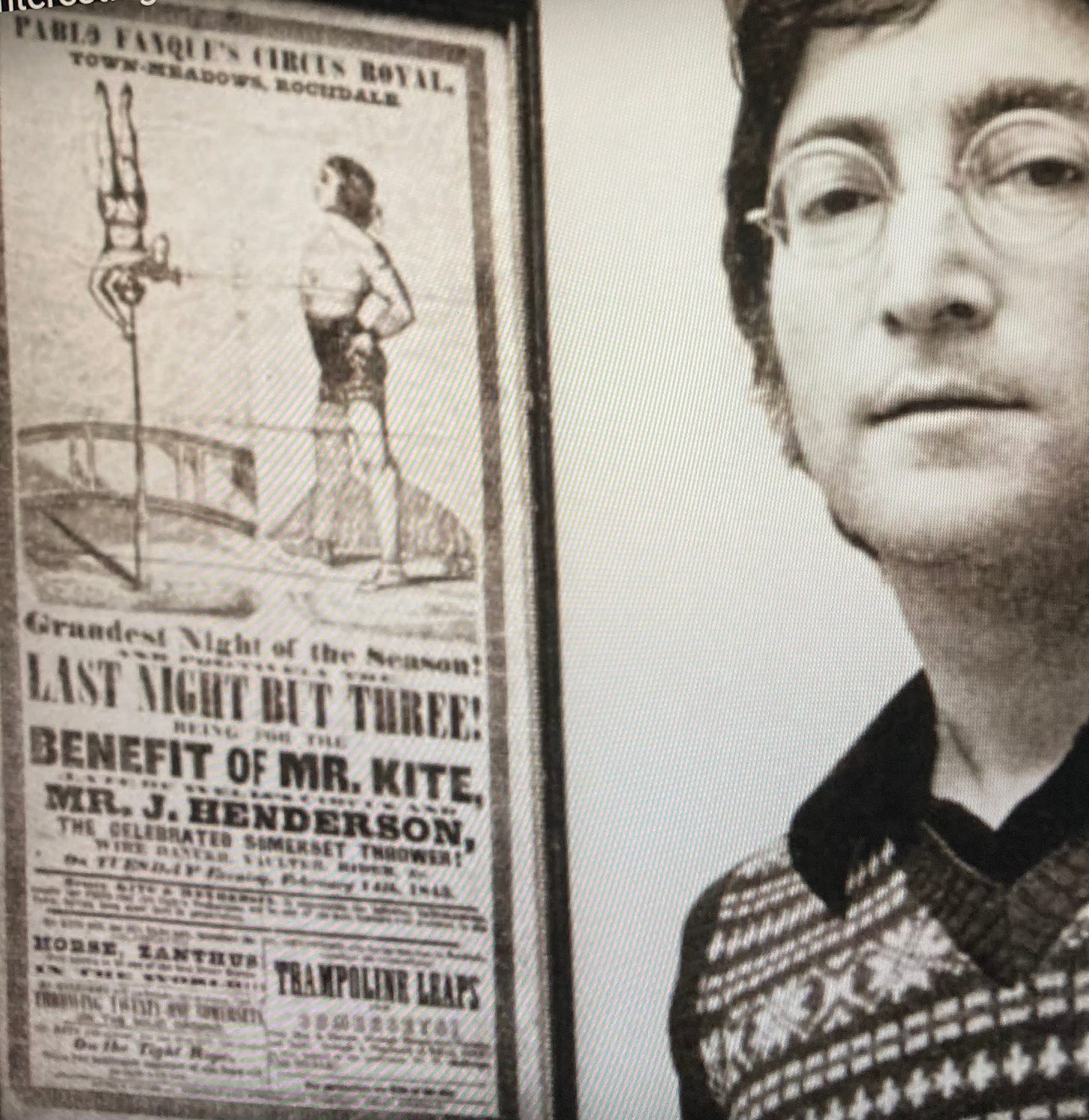It’s the fresh beginning of a new year.
Over the previous December you’d just been writing and recording music with your best mates ever. Lucky you!
Now you’re itching for new ideas and someone suggests you film those new songs so they can accompany the forthcoming record album you’re all putting out later that year.
How exciting!
On Monday evening, January 30, 1967, you and your bandmates all arrive at Knole Park, in Sevenoaks, Kent, England. The filmmakers have set up everything already and you’re geared for fun.
Oh, and your name is John Lennon.

After watching Peter Jackson’s marvelous Get Back, and another Beatles doc on YouTube, I was fascinated to learn that after shooting the (as we now know it) “music video” for “Strawberry Fields Forever” in the aforementioned park, Lennon stopped into an antique shop in the Sevenoaks High Street. As Ian MacDonald writes in his book Revolution in the Head, “[Lennon] picked up a Victorian circus poster advertising ‘LAST NIGHT BUT THREE!’ of a show put on by some travelling tumblers in Rochdale in 1843.”
Apparently it tickled Lennon’s fancy so much he bought the poster, putting it up beside his piano on the wall of his home studio. The poster’s words called out to him like phrases of a song—which he happily composed on the spot (with Paul McCartney’s help, as the following link attests). That song became “Being for the Benefit of Mr. Kite!” which The Beatles recorded on their June 1967 LP Sgt. Pepper’s Lonely Hearts Club Band.
I mention all this because *sigh* this is how Stargazing works.
Stargazing feeds on curiosity (“What will it be like for us to film a song we just wrote in a park at dusk?”), which naturally leads to more curiosity (“This Victorian poster is really interesting. What is it trying to say to me?”), which becomes a further synergy-building exercise (“Could I write a song about this?”) that folds in life lessons and boffo-big “creative quality time.”
BUT wait, there’s more.
Stargazing is the acceptance of energy, timing, connection, and sense-making, bringing it fully to consciousness and probably taking a nod from Daytalking in that it also ropes in relational qualities such as playfulness, receptivity and collaboration, leading to, well, who knows where? There’s a dash of free-floating ambiguity that ironically adds to the aforementioned energy.
It’s a good feeling. Or at least it should be.
My own “who knows where?” on this story came from MacDonald’s book, which states, “[Lennon] once asked [Beatles producer George] Martin to make one of his songs sound like an orange.” (Italics mine.) As the above linked YouTube video to “Mr. Kite” explores further, George Martin explained John Lennon’s songwriting style as not particularly articulate: “He would deal in moods, he would deal in colors, almost… [John would say,] ‘I want to smell the sawdust when I hear that song.’”
All that hooked my curiosity about the condition of synesthesia, which I’d encountered while reading Paul Auster’s biography of writer Stephen Crane, Burning Boy: “These are not merely literary effects but a spontaneous manifestation of Crane’s synesthesia,” Auster explains, “a condition shared by such well-known people as the physicist Richard Feynman, the writer Vladimir Nabokov, musician Duke Ellington, painter Vincent van Gogh, and possibly Arthur Rimbaud, who if nothing else articulates the essential characteristics of synesthesia in his poem ‘Vowels,’ which famously begins: ‘A black, E white, I red, U green, O blue.’”
Stephen Crane’s best-known works mostly include colors in their titles: The Red Badge of Courage, “The Blue Hotel,” “The Bride Comes to Yellow Sky,” which possibly indicates his being a card-carrying member of a worldwide Synesthesia Society.
So it got me thinking: Did John Lennon think in color, too? Did certain words or musical tones lend other sensory cues to him? Do I have synesthesia as well? (There are online tests one can take, of varying degrees of validity, and as far as I can tell I’m as normal as normal can be.)
In the end, it’s been a fascinating couple of days down multiple rabbit holes, with me strangely popping up in places I wouldn’t have expected. It’s what Stargazing does best: lassoing you into worlds beyond your immediate experience, snagging your imagination, and steering you toward new and untested ideas.
But let’s have John Lennon give us the last word.
Go back and watch that “Strawberry Fields Forever” film produced in January 1967. Look at the band’s use of color and how they are painting a decrepit upright piano, webbed with stringy bits and baubles and artifacts from what seems like a distant time.
And I still have more questions.
Ah, Stargazing. How I love it.
Whatever became of The Beatles’ “painted piano” from the film? Is it in a museum somewhere? Wouldn’t it be ironic if it ended up in the same Sevenoaks antique shop where John bought the “Mr. Kite” poster?
What colors did John Lennon choose to paint that piano? Or George? Or Ringo? Or Paul? Did it matter to them?
And what colors would you choose?





Fascinating! I’ve certainly experienced synesthesia, but as best I can recall only under the influence of LSD. It’s a trip, man
Really interesting. I had no idea about the creation of Mr. Kite. And, it sent me down a rabbit hole on Karl Weick